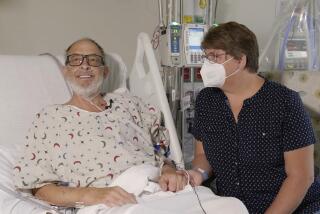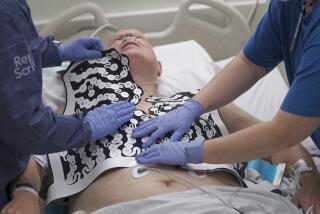For damaged hearts, some added muscle
New drugs and medical procedures are sharply increasing the number of people who survive heart attacks and congestive heart failure, but they have an unfortunate side effect. Survivors’ mobility and lifestyles are often severely restricted because their heart tissue has been extensively damaged and can no longer pump adequate quantities of blood throughout the body.
A growing number of researchers are attempting to circumvent such problems by regenerating heart muscle, and reports last week at the American Heart Assn. meeting in Chicago provided some tantalizing glimpses into where these efforts might be heading.
All of the trials are still “very, very early,” cautioned Dr. Timothy Gardner of the University of Pennsylvania, “but what is exciting is that they have opened a treatment pathway that was not tried before.”
About 7.5 million Americans will suffer heart attacks this year, according to the American Heart Assn. Two-thirds of them will survive -- a much higher rate than in the past -- but many will have severely debilitated hearts that make them candidates for regenerative procedures.
Heart tissue has a limited ability to regenerate on its own, so the loss of extensive amounts of tissue in a heart attack is catastrophic. Some cardiologists have attempted to replace the lost muscle by wrapping muscle tissue from the back around the heart and training it to contract along with the heart tissue, but that has produced only limited successes.
Now cardiologists are attempting to make use of new developments in stem cell technology to augment heart tissue. Researchers remove bone marrow or stem cells from an arm or thigh in a patient’s body, grow them in a laboratory dish to increase their numbers from a few million to a billion or more, then inject them into a heart.
The hope is that the injected cells will become transformed into heart cells and integrated into heart tissues. By using the patient’s own cells, surgeons avoid the need for drugs to suppress the immune system, without running the risk of rejection.
A study by Dr. Francis Pagani of the University of Michigan indicates that is indeed a possibility. Pagani and his colleagues injected cells into the hearts of five patients awaiting heart transplants. Because three of them have since received their transplants, Pagani was able to study their old hearts.
He found that the injected cells not only survived in their new environment, but also began to form muscle fibers. The areas where they were injected also had an increase in the formation of new blood vessels.
“These results give us the first indication that muscle cell transplants, even from an entirely different kind of muscle, could one day be used to help repair damaged, failing hearts,” Pagani said.
Experts estimate that about 50 people worldwide have received cell transplants in their hearts since the procedure was first attempted two years ago by Dr. Philippe Menasche of the Georges Pompidou European Hospital in Paris. Most transplants in the United States have been performed by a team headed by Dr. Nabil Dib of the Arizona Heart Institute in Phoenix. The team has injected the cells extracted from thigh muscle into 11 patients during coronary artery bypass surgery and into five during implantation of a left ventricular assist device.
“We found that the transplanted [cells] survived and thrived in patients,” Dib said. “Areas damaged by heart attack and cardiovascular disease showed evidence of repair and viability,” as measured by PET scans, MRI and echocardiograms. Ejection fractions -- the proportion of blood pumped out of the heart on each beat -- increased 58%, from 22.7% to 35.8%. Normal is about 60%.
One beneficiary of the new procedure is Barry Bucchione, a 53-year-old auto mechanic who was treated at the Cleveland Clinic Heart Center in Ohio. Forty years of smoking caught up with Bucchione in 2001, when he was diagnosed with congestive heart failure. Weakened by the disease, he could barely walk and was forced to stop working.
He received the cell injection in June of that year during bypass surgery and three months later was well enough to return to his job repairing taxicabs. Doctors do not attribute his recovery to the transplant because he also received bypass surgery, but it is clear that the cells did him no harm. “I have no shortness of breath,” he told meeting attendees. “I can run up the hill, and before, I had a problem walking half a block. It’s worked out really well.”
Dr. Manuel Galinanes of the University of Leicester in Britain performed a similar procedure on 14 heart attack survivors using bone marrow cells isolated from the breast bone, injecting the cells during bypass surgery. Within six weeks after the treatment, the physicians noted that the heart pumped more strongly and that the walls of the heart had less abnormal movement.
The team has not yet demonstrated that the injected cells have become integrated into the heart tissue, but “that is the only possible explanation,” Galinanes said.
But Menasche cautioned that there is a potential for problems with the procedure. He said four of the 10 patients he has treated developed ventricular tachycardia, a potentially fatal rapid heartbeat.
All were successfully treated for the problem, he said, but a separate European study by other researchers was halted earlier this year when similar problems developed and one patient in Italy died.
Researchers still have much to do.
Most patients have only been monitored for about 10 months or so, and physicians need to follow their progress much longer to see what happens to the transplanted cells. Researchers would also like to find ways to insert the cells without opening the chest, perhaps by pumping them into the heart through a catheter of the sort used for angiography.
Some of the questions may be answered in a major new trial headed by Menasche that will implant cells in 300 patients in Europe and North America. That trial is sponsored by the Public Assistance Hospital in Paris and by Genzyme Biosurgery, which has developed techniques to grow the cells in the laboratory.






